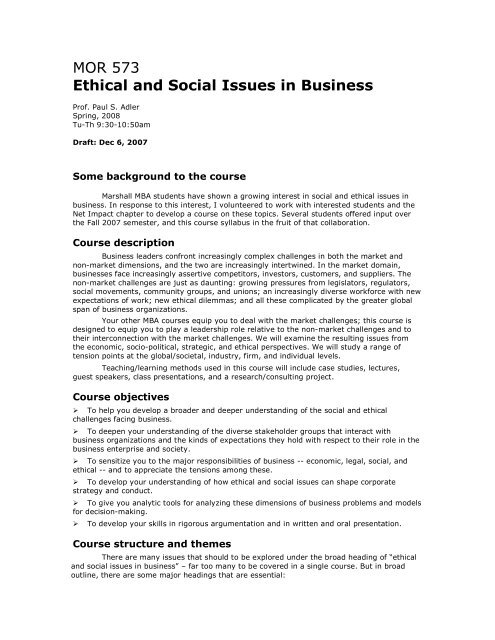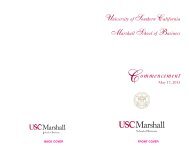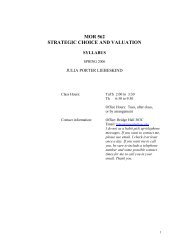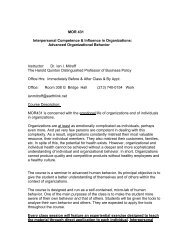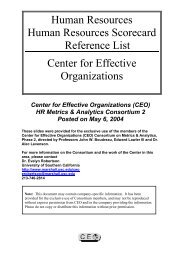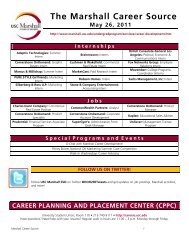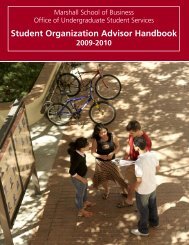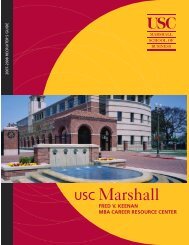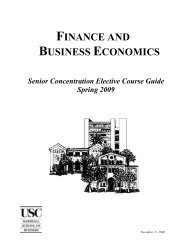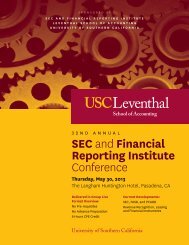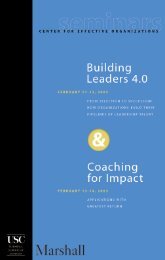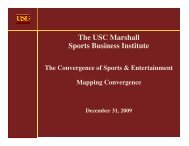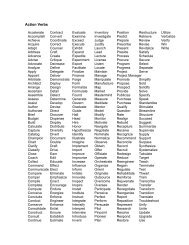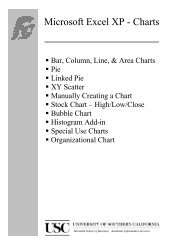MOR 573 Ethical and Social Issues in Business - USC Marshall
MOR 573 Ethical and Social Issues in Business - USC Marshall
MOR 573 Ethical and Social Issues in Business - USC Marshall
Create successful ePaper yourself
Turn your PDF publications into a flip-book with our unique Google optimized e-Paper software.
<strong>MOR</strong> <strong>573</strong><strong>Ethical</strong> <strong>and</strong> <strong>Social</strong> <strong>Issues</strong> <strong>in</strong> Bus<strong>in</strong>essProf. Paul S. AdlerSpr<strong>in</strong>g, 2008Tu-Th 9:30-10:50amDraft: Dec 6, 2007Some background to the course<strong>Marshall</strong> MBA students have shown a grow<strong>in</strong>g <strong>in</strong>terest <strong>in</strong> social <strong>and</strong> ethical issues <strong>in</strong>bus<strong>in</strong>ess. In response to this <strong>in</strong>terest, I volunteered to work with <strong>in</strong>terested students <strong>and</strong> theNet Impact chapter to develop a course on these topics. Several students offered <strong>in</strong>put overthe Fall 2007 semester, <strong>and</strong> this course syllabus <strong>in</strong> the fruit of that collaboration.Course descriptionBus<strong>in</strong>ess leaders confront <strong>in</strong>creas<strong>in</strong>gly complex challenges <strong>in</strong> both the market <strong>and</strong>non-market dimensions, <strong>and</strong> the two are <strong>in</strong>creas<strong>in</strong>gly <strong>in</strong>tertw<strong>in</strong>ed. In the market doma<strong>in</strong>,bus<strong>in</strong>esses face <strong>in</strong>creas<strong>in</strong>gly assertive competitors, <strong>in</strong>vestors, customers, <strong>and</strong> suppliers. Thenon-market challenges are just as daunt<strong>in</strong>g: grow<strong>in</strong>g pressures from legislators, regulators,social movements, community groups, <strong>and</strong> unions; an <strong>in</strong>creas<strong>in</strong>gly diverse workforce with newexpectations of work; new ethical dilemmas; <strong>and</strong> all these complicated by the greater globalspan of bus<strong>in</strong>ess organizations.Your other MBA courses equip you to deal with the market challenges; this course isdesigned to equip you to play a leadership role relative to the non-market challenges <strong>and</strong> totheir <strong>in</strong>terconnection with the market challenges. We will exam<strong>in</strong>e the result<strong>in</strong>g issues fromthe economic, socio-political, strategic, <strong>and</strong> ethical perspectives. We will study a range oftension po<strong>in</strong>ts at the global/societal, <strong>in</strong>dustry, firm, <strong>and</strong> <strong>in</strong>dividual levels.Teach<strong>in</strong>g/learn<strong>in</strong>g methods used <strong>in</strong> this course will <strong>in</strong>clude case studies, lectures,guest speakers, class presentations, <strong>and</strong> a research/consult<strong>in</strong>g project.Course objectives To help you develop a broader <strong>and</strong> deeper underst<strong>and</strong><strong>in</strong>g of the social <strong>and</strong> ethicalchallenges fac<strong>in</strong>g bus<strong>in</strong>ess. To deepen your underst<strong>and</strong><strong>in</strong>g of the diverse stakeholder groups that <strong>in</strong>teract withbus<strong>in</strong>ess organizations <strong>and</strong> the k<strong>in</strong>ds of expectations they hold with respect to their role <strong>in</strong> thebus<strong>in</strong>ess enterprise <strong>and</strong> society. To sensitize you to the major responsibilities of bus<strong>in</strong>ess -- economic, legal, social, <strong>and</strong>ethical -- <strong>and</strong> to appreciate the tensions among these. To develop your underst<strong>and</strong><strong>in</strong>g of how ethical <strong>and</strong> social issues can shape corporatestrategy <strong>and</strong> conduct. To give you analytic tools for analyz<strong>in</strong>g these dimensions of bus<strong>in</strong>ess problems <strong>and</strong> modelsfor decision-mak<strong>in</strong>g.To develop your skills <strong>in</strong> rigorous argumentation <strong>and</strong> <strong>in</strong> written <strong>and</strong> oral presentation.Course structure <strong>and</strong> themesThere are many issues that should to be explored under the broad head<strong>in</strong>g of “ethical<strong>and</strong> social issues <strong>in</strong> bus<strong>in</strong>ess” – far too many to be covered <strong>in</strong> a s<strong>in</strong>gle course. But <strong>in</strong> broadoutl<strong>in</strong>e, there are some major head<strong>in</strong>gs that are essential:
2* Introduction* Bus<strong>in</strong>ess as a contested social <strong>in</strong>stitution* Perspectives <strong>and</strong> criteria for assess<strong>in</strong>g bus<strong>in</strong>ess’s economic <strong>and</strong> social performance* Ethics* Economics* Managerial/strategic* Technological change <strong>and</strong> <strong>in</strong>tellectual property rights* Bus<strong>in</strong>ess’s relations with key stakeholders* Investors* Government* Natural environment* Suppliers* Customers* Employees* Unions* Community* Media* Activist organizations* <strong>Social</strong> entrepreneurs* Organizational governance* Goals: bus<strong>in</strong>ess <strong>and</strong> social entrepreneurship* Processes: external <strong>and</strong> <strong>in</strong>ternal l<strong>in</strong>kages* Personal challenges <strong>in</strong> deal<strong>in</strong>g with these issues.With<strong>in</strong> this broad outl<strong>in</strong>e, the course focuses on cases that reflect the objectiveimportance of the issues as well as the student design team’s <strong>in</strong>terests. S<strong>in</strong>ce environmentalissues are rank high on both lists, this year we will emphasize susta<strong>in</strong>ability issues <strong>in</strong> ourchoice of cases.ProjectsA project will be the centerpiece of the course. You can work as a team (4 studentsmaximum) or as an <strong>in</strong>dividual. You will choose the topic as a function of your personal<strong>in</strong>terests <strong>and</strong> <strong>in</strong> discussion with the <strong>in</strong>structor. There are two generic types of topics: (a) an“ethics <strong>and</strong> social performance” audit of an organization that you are <strong>in</strong>terested <strong>in</strong>, <strong>and</strong> (b) ananalysis of a social issue that you are <strong>in</strong>terested <strong>in</strong>. Possible topics <strong>in</strong>clude: a market<strong>in</strong>g planfor a social-entrepreneurship venture, Wal-Mart’s employment or environmental practices,sweatshops <strong>in</strong> LA, pollution controls at the LA ports, etc. You may not rely exclusively onlibrary research: you must also meet with or at least <strong>in</strong>terview by phone a range of therelevant stakeholders.You are encouraged to select an <strong>in</strong>dustry of <strong>in</strong>terest to you, <strong>and</strong> identify asocial/ethical issue relevant to actors with<strong>in</strong> that <strong>in</strong>dustry. For example:* automobile: pollution, green manufactur<strong>in</strong>g, alternative transportation* food: agriculture supply cha<strong>in</strong>, farm subsidies, organics* f<strong>in</strong>ance: microf<strong>in</strong>ance, social <strong>in</strong>vestment funds* energy: alternative energy sources* hous<strong>in</strong>g/real estate: urban development* education: public, charter, <strong>and</strong> private schools.You will need to select a specific client who is the <strong>in</strong>tended audience of your projectreport. You can choose your client from a number of possibilities:* a firm’s CEO or board* an activist organization’s leader or board* a relevant <strong>in</strong>dustry regulator* a relevant legislative committee.In the course of the project research, you will need to:
3* identify a client;* identify the stakeholders <strong>and</strong> their <strong>in</strong>terests;* identify <strong>and</strong> analyze the relevant social, economic, <strong>and</strong>/or legal factors;* identify the key ethical <strong>and</strong> social issues;* identify <strong>and</strong> analyze the available options; <strong>and</strong>* propose <strong>and</strong> defend a resolution for your client.As described <strong>in</strong> more detail <strong>in</strong> the Appendix, each group will make two presentationson their project to the entire class, one <strong>in</strong> the form of a progress report <strong>and</strong> the other at theend of the term. I will also meet with each group three times over the course of the semesterto review your progress. The f<strong>in</strong>al deliverable is the oral report to the class plus a “talk<strong>in</strong>gdocument.”I realize that you are busy with many other commitments, <strong>and</strong> moreover, classprojects are difficult because of their team coord<strong>in</strong>ation requirements. We will therefore usesome class time alleviate those pressures. However, I assume I will also need to meet outsideclass time with your team, dur<strong>in</strong>g weekdays, even<strong>in</strong>gs, or weekends as a function of ourvarious schedule constra<strong>in</strong>ts.Topic memosOver the course of the semester, you will need to submit a total of 4 topic memos.Each memo will present your analysis of the case or sets of read<strong>in</strong>gs assigned for a specificclass session. You can choose any 4 of the class sessions to fit your <strong>in</strong>terests <strong>and</strong> schedule.The memos will be about 3-5 pages s<strong>in</strong>gle-spaced. They should answer the Key Questionsspecified <strong>in</strong> the Session-by-session description below. They are due at the start of class; youcan email me ahead of time or give it to me at the start of the session. I cannot accept lateassignments.Class attendance <strong>and</strong> participation Students are expected to attend class regularly. Class attendance will be part of the classparticipation evaluation, so absences will be penalized. If you are absent for a class, you can reduce by 50% the impact on your participationgrade by prepar<strong>in</strong>g an extra topic memo for the materials under discussion that day, so longas I receive it with<strong>in</strong> 24 hours of the end of class. S<strong>in</strong>ce dur<strong>in</strong>g class I may call on students at any time, please avoid embarrassment bytell<strong>in</strong>g me before class if you are not prepared. If you are uncomfortable with class participation, please let me know at the beg<strong>in</strong>n<strong>in</strong>g ofterm <strong>and</strong> I will work with you to help you overcome this barrier.Grad<strong>in</strong>gThe project will account for the greater part of the course grade. The project grade willbe a group grade, adjusted up or down as a function of team members’ peer evaluations (seeAppendix).Project 57%Individual class participation 15%Topic memos (4 x 7%) 28%Total 100%Classroom etiquetteAn atmosphere of mutual respect is <strong>in</strong> order. So please...
4 arrive at class on time: late arrivals are disruptive to your fellow classmates <strong>and</strong> to theconduct of the class;turn off your cell phones before you enter the classroom;do not engage <strong>in</strong> side conversations dur<strong>in</strong>g class;do not pack up <strong>and</strong> leave towards the end of the class until it is clear the class is over.Use of laptops dur<strong>in</strong>g classLaptop use is not allowed dur<strong>in</strong>g this class. In this class, it is far important toparticipate than to take detailed notes. A few h<strong>and</strong>-written notes will suffice. After each class,I recommend you can take some time to reflect on the discussion <strong>and</strong> type up whatever notesseem useful.Academic <strong>in</strong>tegrityThe follow<strong>in</strong>g <strong>in</strong>formation on academic <strong>in</strong>tegrity, dishonesty, <strong>and</strong> the grad<strong>in</strong>g st<strong>and</strong>ardare placed here at the recommendation of the School of Bus<strong>in</strong>ess Adm<strong>in</strong>istration Faculty <strong>and</strong>are taken from the Faculty H<strong>and</strong>book:“The University, as an <strong>in</strong>strument of learn<strong>in</strong>g, is predicated on the existence of anenvironment of <strong>in</strong>tegrity. As members of the academic community, faculty, students,<strong>and</strong> adm<strong>in</strong>istrative officials share the responsibility for ma<strong>in</strong>ta<strong>in</strong><strong>in</strong>g this environment.Faculty have the primary responsibility for establish<strong>in</strong>g <strong>and</strong> ma<strong>in</strong>ta<strong>in</strong><strong>in</strong>g anatmosphere <strong>and</strong> attitude of academic <strong>in</strong>tegrity such that the enterprise may flourish <strong>in</strong>an open <strong>and</strong> honest way. Students share this responsibility for ma<strong>in</strong>ta<strong>in</strong><strong>in</strong>g st<strong>and</strong>ardsof academic performance <strong>and</strong> classroom behavior conducive to the learn<strong>in</strong>g process.Adm<strong>in</strong>istrative officials are responsible for the establishment <strong>and</strong> ma<strong>in</strong>tenance ofprocedures to support <strong>and</strong> enforce those academic st<strong>and</strong>ards. Thus, the entireUniversity community bears the responsibility for ma<strong>in</strong>ta<strong>in</strong><strong>in</strong>g an environment of<strong>in</strong>tegrity <strong>and</strong> for tak<strong>in</strong>g appropriate action to sanction <strong>in</strong>dividuals <strong>in</strong>volved <strong>in</strong> anyviolation. When there is a clear <strong>in</strong>dication that such <strong>in</strong>dividuals are unwill<strong>in</strong>g or unableto support these st<strong>and</strong>ards, they should not be allowed to rema<strong>in</strong> <strong>in</strong> the University.”(Faculty H<strong>and</strong>book, 1994: 20)Academic dishonesty <strong>in</strong>cludes: (Faculty H<strong>and</strong>book, 1994: 21-22) Exam<strong>in</strong>ation behavior - any use of external assistance dur<strong>in</strong>g an exam<strong>in</strong>ation shall beconsidered academically dishonest unless expressly permitted by the teacher. Fabrication - any <strong>in</strong>tentional falsification or <strong>in</strong>vention of data or citation <strong>in</strong> an academicexercise will be considered a violation of academic <strong>in</strong>tegrity. Plagiarism - the appropriation <strong>and</strong> subsequent pass<strong>in</strong>g off of another’s ideas or words asone’s own. If the words or ideas of another are used, acknowledgment of the orig<strong>in</strong>al sourcemust be made through recognized referenc<strong>in</strong>g practices. Other types of academic dishonesty - submitt<strong>in</strong>g a paper written by or obta<strong>in</strong>ed fromanother, us<strong>in</strong>g a paper or essay <strong>in</strong> more than one class without the teacher’s expresspermission, obta<strong>in</strong><strong>in</strong>g a copy of an exam<strong>in</strong>ation <strong>in</strong> advance without the knowledge <strong>and</strong> consentof the teacher, chang<strong>in</strong>g academic records outside of normal procedures <strong>and</strong>/or petitions,us<strong>in</strong>g another person to complete homework assignments or take-home exams without theknowledge or consent of the teacher.Students with disabilitiesAny student request<strong>in</strong>g academic accommodations based on a disability is required toregister with Disability Services <strong>and</strong> Programs (DSP) each semester. A letter of verification forapproved accommodations can be obta<strong>in</strong>ed from DSP. Please be sure the letter is delivered tothe <strong>in</strong>structor as early <strong>in</strong> the semester as possible. DSP is located <strong>in</strong> STU 301 <strong>and</strong> is open from8:30 am to 5:00 pm, Monday through Friday. The phone number of DSP is (213) 740-0776Returned papers
5Papers unclaimed by a student will be discarded after four weeks, <strong>and</strong> so will not beavailable should a grade appeal be pursued by the student follow<strong>in</strong>g receipt of his/her coursegrade.COURSE OUTLINE(draft version: to be ref<strong>in</strong>ed with student design team)Date Theme Case Project milestonesIntroduction: The contested place of bus<strong>in</strong>ess <strong>in</strong> societyTues Jan 15 Introductions Ford P<strong>in</strong>to (h<strong>and</strong>ed out <strong>in</strong>class)Thurs Jan 17Bus<strong>in</strong>ess undereconomic <strong>and</strong> socialpressureTues Jan 22Perspectives <strong>and</strong> criteriaProject bra<strong>in</strong>storm<strong>in</strong>g sessionThurs Jan 24 Ethics Selections from: A.Weston: 21 st Century<strong>Ethical</strong> ToolboxTues Jan 29 Managerial/strategy Amanco: Develop<strong>in</strong>g asusta<strong>in</strong>ability scorecardThurs Jan 31 Political-economy Week of 1/29: Topicdef<strong>in</strong>ed – team meetswith <strong>in</strong>structor outsideclass timeTues Feb 5 Comb<strong>in</strong><strong>in</strong>g perspectives AIDS <strong>in</strong> AfricaBus<strong>in</strong>ess’s relations with key stakeholdersThurs Feb 7 Investors Susta<strong>in</strong>able development<strong>and</strong> socially responsible<strong>in</strong>vest<strong>in</strong>g: ABB <strong>in</strong> 2000Tues Feb 12 Government The politics of tobaccocontrolThurs Feb 14 Government (cont’d) Workers’ rights <strong>and</strong> globaltrade: The US-CambodiaBilateral Trade AgreementTues Feb 19 Environment Wal-Mart’s susta<strong>in</strong>abilitystrategyThurs Feb 21 Environment (cont’d) UBS <strong>and</strong> climate changeTues Feb 26Thurs Feb 28Project: progress reports to classProject: progress reports to class
6Date Theme Case Project milestonesTues Mar 4 Suppliers Charles Veillon Sometime between 2/27 <strong>and</strong> 3/6:Team meets with <strong>in</strong>structor outsideclass time to review progress reportThurs Mar 6 Customers Beech-NutTues Mar 11 Employees Deloitte & ToucheThurs Mar 13 Unions La ConexionFamiliarTues Mar 25 Community Canyon JohnsonUrban FundThurs Mar 27Tues April 1Thurs April 3ActivistorganizationsStrategic activism:The Ra<strong>in</strong>forestAction NetworkWorkshop on rough-cut presentationsWorkshop on rough-cut presentationsTues April 8Thurs April 10Tues April 15<strong>Social</strong>entrepreneursIntegrat<strong>in</strong>g social<strong>and</strong> bus<strong>in</strong>ess goalsWhen it all goessourGreen Dot publicschoolsOrganizational governancePatagoniaWorldComPersonal challengesSometime between 4/2 <strong>and</strong> 4/10:Team meets with <strong>in</strong>structor outsideclass time to review rough-cutThurs April 17 St<strong>and</strong><strong>in</strong>g up Martha McCaskeyTues April 22Thurs April 24F<strong>in</strong>al presentations to classF<strong>in</strong>al presentations to classTues April 29Wrap up
7TOPICS, ASSIGNED READING, ASSIGNMENT QUESTIONS,OPTIONAL BACKGROUND READINGSINTRODUCTION: THE CONTESTED PLACE OF BUSINESS IN SOCIETYTues Jan 15: IntroductionsCase: Ford P<strong>in</strong>to (h<strong>and</strong>ed out <strong>in</strong> class)Thurs Jan 17: Bus<strong>in</strong>ess under economic <strong>and</strong> social pressureAssigned read<strong>in</strong>gs: Net Impact mission statement M. Friedman: “The social responsibility of bus<strong>in</strong>ess is to <strong>in</strong>crease its profits” New YorkTimes Magaz<strong>in</strong>e, Sept 13, 1970 H. Leavitt, “The dangers of social responsibility” HBR Sept-Oct 1958 K. Sundaram <strong>and</strong> A. C. Inkpen, “The corporate objective revisited,” OrganizationScience, May-June 2004 R. E. Freeman, A. C. Wicks, <strong>and</strong> B. Parmar, “Stakeholder theory <strong>and</strong> ‘The corporateobjective revisited,’” Organization Science, May-June 2004 D. Doane, “The myth of CSR,” Stanford <strong>Social</strong> Innovation Review, Fall 2005Assignment questions:1. In your view, should corporations attempt to take on social responsibilities beyondthose to their <strong>in</strong>vestors <strong>and</strong> the law? How do you respond to the arguments aga<strong>in</strong>styour position?2. What conditions external to the corporation would encourage or discourage corporatesocial responsibility?Optional background read<strong>in</strong>g: Michael Bradley <strong>and</strong> C<strong>in</strong>dy A. Schipani, Anant K. Sundaram, <strong>and</strong> James P. Walsh.(1999) “The Purposes <strong>and</strong> Accountability of the Corporation <strong>in</strong> Contemporary Society:Corporate Governance at a Crossroads.” Law <strong>and</strong> Contemporary Problems 62: 9-47 John Kay <strong>and</strong> Aubrey Silberston. (1995) “Corporate Governance.” National InstituteEconomic Review 95 (3): 84-97. D. Millon, “Theories of the corporation.” Duke Law Review, 1990 W. T. Allen, “ Our schizophrenic conception of the bus<strong>in</strong>ess corporation” Cardozo LawReview 1992Tues Jan 22: Project bra<strong>in</strong>storm<strong>in</strong>g sessionPERSPECTIVES AND CRITERIAThurs Jan 24: EthicsAssigned read<strong>in</strong>g: Selections from A. Weston: 21st Century <strong>Ethical</strong> Toolbox (Oxford U.P. 2001)Assignment questions:1. Use Weston’s framework to analyze the P<strong>in</strong>to case from Jan 15.Tues Jan 29: Managerial/strategyCase: Amanco: Develop<strong>in</strong>g a susta<strong>in</strong>ability scorecard (HBS 107-038)
8Assigned read<strong>in</strong>g: Strategies beyond the market (HBS 707-469)Assignment questions:1. Is the Amanco strategy an example of corporate social responsibility or corporate self<strong>in</strong>terest?2. Why does Salas need a strategy map <strong>and</strong> balanced scorecard to pursue his triplebottom-l<strong>in</strong>e objectives?3. Why did he feel he needed to modify the more st<strong>and</strong>ard strategy map/BSC format?4. What challenges face Salas as he tries to implement this strategy? Whatrecommendations do you have for him?Optional background read<strong>in</strong>gs: D. P. Baron, “Private politics, corporate social responsibility, <strong>and</strong> <strong>in</strong>tegrated strategy,” J.of Economics & Management Strategy, Spr<strong>in</strong>g 2001 R. S. Kaplan <strong>and</strong> D. P. Norton, “Transform<strong>in</strong>g the Balanced Scorecard from PerformanceMeasurement to Strategic Management: Part I,” Account<strong>in</strong>g Horizons (March 2001):87–104.Thurs Jan 31: Political-economyAssigned read<strong>in</strong>gs: Adam Smith: selection from The Wealth of Nations F.A. Hayek, “The use of knowledge <strong>in</strong> society,” American Economic Review Sept 1945 M. <strong>and</strong> R. Friedman, selections from Free to Choose F. Engels, <strong>Social</strong>ism: Utopian <strong>and</strong> Scientific, part 3. E. O. Wright, “Compass po<strong>in</strong>ts: Towards a socialist alternative,” New Left Review, Sept-Oct 2006Assignment questions:1. What do these various conceptions of the political-economy of capitalism suggest aboutthe desirability <strong>and</strong> feasibility of corporations assum<strong>in</strong>g broader social responsibility?Optional background read<strong>in</strong>gs: G. Esp<strong>in</strong>g-Andersen <strong>and</strong> K. van Kersbergen, “Contemporary research on socialdemocracy,” Ann. Rev. Sociol. 1992Thurs Feb 5: Comb<strong>in</strong><strong>in</strong>g perspectives: <strong>in</strong>tellectual property rightsCase: Life, death, <strong>and</strong> property rights: The pharmaceutical <strong>in</strong>dustry faces AIDS <strong>in</strong> Africa (HBS702-049)Assignment questions:1. How should the pharmaceutical companies respond to the plague of AIDS <strong>in</strong> Africa?2. What strategy should they follow to protect their property rights?3. How far should they be will<strong>in</strong>g to go? What are the costs <strong>and</strong> benefits?Optional background read<strong>in</strong>gs: Alan F. Holmer, “The case for <strong>in</strong>novation: The role of <strong>in</strong>tellectual property protection,”Statement before the Economist’s Second Annual Pharmaceuticals Roundtable, Nov 20,2002 S. Taurel, “The Worldwide Campaign aga<strong>in</strong>st Pharmaceutical Innovation.” AmericanEnterprise Institute, March 19, 2003 Heller, M. A., R. S. Eisenberg, 1998. “Can patents deter <strong>in</strong>novation? The anticommons<strong>in</strong> biomedical research.” Science. 280 (5364) 698-701. Doctors Without Borders, “Equitable access: Scal<strong>in</strong>g up HIV/AIDS treatment <strong>in</strong>develop<strong>in</strong>g countries,” Dec. 2002 Debra Watson, “US pharmaceutical companies reap huge profits from AIDS drugs,”World <strong>Social</strong>ist web site, June 5, 1999
9 L. Lessig, “The people own ideas!” Technology Review, June 2005BUSINESS’S RELATIONS WITH KEY STAKEHOLDERSTues Feb 7: InvestorsCase: Susta<strong>in</strong>able development <strong>and</strong> socially responsible <strong>in</strong>vest<strong>in</strong>g: ABB <strong>in</strong> 2000 (HBS 701-082)Assignment questions:Optional background read<strong>in</strong>gs: The fiduciary relationship: A legal perspective (HBS 304-064) When <strong>in</strong>vest<strong>in</strong>g <strong>and</strong> social objectives meet (HBS 106-043) <strong>Social</strong> Investment Forum, 2005 Report on <strong>Social</strong>ly Responsible Invest<strong>in</strong>g Trends <strong>in</strong> theUnited States, Wash<strong>in</strong>gton DC, Jan 2006 Peter Camejo, ed., The SRI Advantage: Why <strong>Social</strong>ly Responsible Invest<strong>in</strong>g HasOutperformed F<strong>in</strong>ancially. New Society Publishers, 2002.Thurs Feb 12: GovernmentCase: The politics of tobacco control (KEL 062)Assignment questions:Optional background read<strong>in</strong>gs: Note on lobby<strong>in</strong>g (HBS 707-471) Public law: The rules of the game (HB 806-172) Influenc<strong>in</strong>g power: review<strong>in</strong>g the conduct <strong>and</strong> content of corporate lobby<strong>in</strong>g(Susta<strong>in</strong>ability, WWF)Thurs Feb 14: Government (cont’d)Case: Workers’ rights <strong>and</strong> global trade: The US-Cambodia Bilateral Trade Agreement (HBS703-034)Assignment questions:1. Did Cambodia do the right th<strong>in</strong>g <strong>in</strong> sign<strong>in</strong>g this agreement?2. How should we portray the agreement? Is it a case of progress or protectionism? Onwhat basis is it one or the other?3. Look<strong>in</strong>g ahead, what should Cambodia do? What advice would you give to M<strong>in</strong>isterPrasidh?Optional background read<strong>in</strong>gs: The World Trade Organization (HBS 703-015) To trade or not to trade: NAFTA (HBS 705-034) Inequality <strong>and</strong> globalization (HBS 705-040) J. Bhagwati, “Why the critics of globalization are mistaken” De Economist, 2007 K. Watk<strong>in</strong>s, “Trade, globalization <strong>and</strong> poverty reduction: Why the rules of the gamematter,” presentation at the Carnegie Endowment for International Peace Sem<strong>in</strong>ar onworld trade <strong>and</strong> poverty, July 2002 A. Sen, Development as Freedom, Oxford U.P. 1999 J. E. Stiglitz, Globalization <strong>and</strong> its discontents, Norton 2003 J. E. Stiglitz, The oversell<strong>in</strong>g of globalization, <strong>in</strong> Globalization: What's New, edited byMichael M. We<strong>in</strong>ste<strong>in</strong>, Columbia University Press, 2005, pp. 228-261. E. Aisbett, “Why are the critics so conv<strong>in</strong>ced that globalization is bad for the poor?”NBER, 2004
10 Elissa Alben, “GATT <strong>and</strong> the Fair Wage: A Historical Perspective on the Labor-TradeL<strong>in</strong>k,” Columbia Law Review, 101, 6: 1410-1447.Tues Feb 19: EnvironmentCase: Wal-Mart’s susta<strong>in</strong>ability strategy (Stanford OIT-71)Assignment questions:1. Given the fact that Wal-Mart’s customers generally are unwill<strong>in</strong>g to pay a premium forenvironmentally friendly products, how is the company deriv<strong>in</strong>g bus<strong>in</strong>ess value from itssusta<strong>in</strong>ability strategy, or if not, how can it ensure that it does <strong>in</strong> the future?2. Imag<strong>in</strong>e that you are Andy Ruben or Tyler Elm, evaluat<strong>in</strong>g the progress of theelectronics, seafood, <strong>and</strong> textiles networks. Which networks have been mostsuccessful? What expla<strong>in</strong>s the success or lack of it <strong>in</strong> these networks?3. How is Wal-Mart motivat<strong>in</strong>g its suppliers to cont<strong>in</strong>uously reduce the environmentalimpacts of their products <strong>and</strong> process, <strong>and</strong> to share <strong>in</strong>formation about how they dothat? How can the company stimulate the development of disruptive, breakthrough<strong>in</strong>novations?4. Focus on one network: if you last name beg<strong>in</strong>s with the letter A through F, focus onseafood; G-M electronics: N-Z textiles. For the network to which you have beenassigned, propose one new “game changer” or “<strong>in</strong>novation project” not described <strong>in</strong> thecase. To support your proposal, outl<strong>in</strong>e the environmental benefits, the profitopportunity for Wal-Mart, the greatest challenges <strong>in</strong> implementation, <strong>and</strong> how Wal-Martcould overcome them.5. As evidenced by Ex 12, Wal-Mart’s susta<strong>in</strong>ability strategy has generally been veryprofitable. However, two <strong>in</strong>itiatives described <strong>in</strong> the case benefit society <strong>and</strong> theenvironment while apparently reduced Wal-Mart’s profits. Identify those two <strong>in</strong>itiatives<strong>and</strong> imag<strong>in</strong>e that you are their <strong>in</strong>ternal champion. How do you propose to justifypursu<strong>in</strong>g those <strong>in</strong>itiatives?Optional background read<strong>in</strong>gs: S. L. Hart, “Beyond green<strong>in</strong>g: strategies for a susta<strong>in</strong>able world,” HBR Jan-Feb 1997 www.susta<strong>in</strong>ability.com Geyer <strong>and</strong> Jackson, “Supply loops <strong>and</strong> their constra<strong>in</strong>ts: the <strong>in</strong>dustrial ecology ofrecycl<strong>in</strong>g <strong>and</strong> reuse” Calif. Mgt. Rev. W<strong>in</strong>ter 2004 G. Hard<strong>in</strong>, “The tragedy of the commons,” Science. 162: 1243-1248 M. J. Epste<strong>in</strong>, “Improv<strong>in</strong>g environmental management with full environmental costaccount<strong>in</strong>g,” Epste<strong>in</strong>, Environmental Quality Management, 1996 Environment Agency, UK, “Corporate Environmental Governance” 2004 J. Howard, J. Nash, J. Ehrenfeld, “St<strong>and</strong>ard or smokescreen? Implementation of avoluntary environmental code,” California Management Review, W<strong>in</strong>ter 2000Thurs Feb 21: Environment (cont’d)Case: UBS <strong>and</strong> climate change: Warm<strong>in</strong>g up to global action? (HBS 707-511)Assignment questions:1. Which of the four options should Suter support <strong>and</strong> why?2. If UBS decides to adopt any of the four options, do you recommend reduc<strong>in</strong>g thecompany’s own energy consumption, or should UBS buy carbon offsets? If yourecommend the latter, is your recommendation to <strong>in</strong>vest <strong>in</strong> CERs, ERUs, or VERs?Optional background read<strong>in</strong>gs: Global climate change <strong>and</strong> emissions trad<strong>in</strong>g (HBS 707-015) D. Cullenward <strong>and</strong> D. G. Victor, “Mak<strong>in</strong>g carbon markets work,” Scientific American,Sept 24, 2007
11 Bill Baue, “Emissions trad<strong>in</strong>g commodifies carbon, but does it really solve climatechange?” 2007Tues Feb 26: Project progress reports to classThurs Feb 28: Project progress reports to classTues Mar 4: SuppliersCase: Charles Veillon (A) (HBS 307-002)Assignment questions:1. Did Zwahlen term<strong>in</strong>ate relations with exist<strong>in</strong>g carpet suppliers too quickly?2. To what extent if any is the use of child labor <strong>and</strong> other supplier practices theresponsibility of Zwahlen <strong>and</strong> his company?3. As Zwahlen, what if any further action would you take regard<strong>in</strong>g child labor <strong>and</strong> supplierwork practices?4. If Zwahlen decides to take further action, would you recommend that Veillon actunilaterally or that it collaborate with others? If the latter, what k<strong>in</strong>d of collaborationwould you recommend?5. As Zwahlen, would you accept the <strong>in</strong>vitation to appear on “La Marche du Siecle”?Optional background read<strong>in</strong>gs: Harrison, J. Scorse, “Improv<strong>in</strong>g the conditions of workers? M<strong>in</strong>imum wage legislation<strong>and</strong> anti-sweatshop activism,” California Management Review, W<strong>in</strong>ter 2006) Locke, R., Kochan, M., Romis, M., <strong>and</strong> Q<strong>in</strong>, F., “Beyond corporate codes of conduct:Work organization <strong>and</strong> labour st<strong>and</strong>ards at Nike’s suppliers,” International LabourReview, 2007Thurs Mar 6: CustomersCase: Beech-Nut Nutrition Corporation (A-1) (HBS 392-084)Assignment questions:1. In Anderson’s position, what would be your concerns on learn<strong>in</strong>g about the Friday<strong>in</strong>cident?2. In Storer’s position, what would be your assessment of the apple juice situation?3. What are the orig<strong>in</strong>s of Anderson’s problems?4. What would you advise Anderson to do? What do you th<strong>in</strong>k he will do?Optional background read<strong>in</strong>gs: J. P. Foley, “Ethics <strong>in</strong> advertis<strong>in</strong>g” J. Public Policy <strong>and</strong> Market<strong>in</strong>g, Fall 1998 Pontificial Council for <strong>Social</strong> Communications (1997), Ethics <strong>in</strong> Advertis<strong>in</strong>g. Vatican City:Vatican Documents G. R. Laczniak, “Reflections on the 1997 Vatican Statements regard<strong>in</strong>g ethics <strong>in</strong>advertis<strong>in</strong>g” J. Public Policy <strong>and</strong> Market<strong>in</strong>g, Fall 1998 Deception <strong>in</strong> bus<strong>in</strong>ess: A legal perspective (HBS 306-019) Note on <strong>in</strong>dividual <strong>and</strong> corporate liability (HBS 305-049) M. E. Drumwright <strong>and</strong> P. E. Murphy, “How advertis<strong>in</strong>g practitioners view ethics,” Journalof Advertis<strong>in</strong>g, Summer 2004Tues Mar 11: EmployeesCases: Deloitte & Touche: Chang<strong>in</strong>g the workplace (B) (HBS 9-300-013)Assignment questions:
121. What were the factors account<strong>in</strong>g for Deloitte & Touche’s poor track record withwomen’s careers?2. What expla<strong>in</strong>s the progress they have made?3. What should Copel<strong>and</strong> do?Optional background read<strong>in</strong>gs: William A. Darity, Jr., <strong>and</strong> Patrick L. Mason, “Evidence on discrim<strong>in</strong>ation <strong>in</strong>employment: Codes of color, codes of gender,” J. Economic Perspectives, Spr<strong>in</strong>g 1998 James J. Heckman, “Detect<strong>in</strong>g Discrim<strong>in</strong>ation,” J. Economic Perspectives, Spr<strong>in</strong>g 1998Thurs Mar 13: UnionsCase: Spr<strong>in</strong>t: La Conexion Familiar (A) (Ivey 9A97C001)Assignment questions:1. What is the problem that Spr<strong>in</strong>t faces?2. What should Spr<strong>in</strong>t management do? What implications will this decision have on thefuture of its long distance service market?3. How important is the Communications Workers of America’s potential reaction to anydecision Spr<strong>in</strong>t makes?Optional background read<strong>in</strong>gs: Barry Hirsch, “What do unions do for economic performance?” Journal of LaborResearch (Summer 2004) J. P. Ferguson <strong>and</strong> T. A. Kochan, “Sequential failures <strong>in</strong> workers’ right to organize,” MITMarch 2006 M. Levitt, Confessions of a union buster (Crown, 1993)Tues Mar 25: CommunityCase: Canyon Johnson Urban Fund (HBS 706-442)Assignment questions:1. What are Canyon Johnson Urban Fund’s <strong>in</strong>ternal rates of return for the Sunset <strong>and</strong> theHollywood projects? (CJUF believes it can obta<strong>in</strong> debt f<strong>in</strong>anc<strong>in</strong>g at a 5% <strong>in</strong>terest ratefor a term of 25 years. In your valuation of Hollywood <strong>and</strong> Highl<strong>and</strong>, disregard thefund’s option for partial ownership of the hotel.)2. Which project should Turner choose?Optional background read<strong>in</strong>gs: Michael E. Porter. “Realiz<strong>in</strong>g the Inner City Retail Opportunity: Progress <strong>and</strong> NewDirections,” report by ICIC <strong>and</strong> the Boston Consult<strong>in</strong>g Group, 2006Thurs Mar 27: Activist organizationsCase: Anatomy of a corporate campaign: Ra<strong>in</strong>forest Action Network <strong>and</strong> Citigroup (A, B)(Stanford P-42A, P-42B)Assignment questions:1. Was it strategically wise for RAN to launch a campaign on project f<strong>in</strong>ance? Can RANrealistically expect to affect project f<strong>in</strong>ance, which is provided by banks around theworld?2. Was Citigroup a good or bad target for RAN? Why not focus on project contractorsthemselves?3. At the end of the B case, should Citibank have adopted its new policy? How should itimplement that policy?4. How should RAN enforce <strong>and</strong> monitor Citigroup’s compliance? Is Citigroup’s report<strong>in</strong>gpledge adequate?5. What strategy should RAN use to obta<strong>in</strong> agreements with The Liquidators?
13Optional background read<strong>in</strong>gs: D. Spar, L. T. La Mur, “The power of activism: Assess<strong>in</strong>g the impact of NGOs on globalbus<strong>in</strong>ess” California Management Review Spr<strong>in</strong>g 2003Tues April 1: Workshop on rough-cut presentationsThurs April 3: Workshop on rough-cut presentationsTues April 8: <strong>Social</strong> entrepreneursCase: Green Dot public schools: To collaborate or compete? (HBS 307-086)Assignment questions:Optional background read<strong>in</strong>gs: Note on student outcomes <strong>in</strong> US public education (HBS 307-068) J. Kozol, The Shame of the Nation: The Restoration of Apartheid School<strong>in</strong>g <strong>in</strong> America(2005), Letters to a Young Teacher (2007)ORGANIZATIONAL GOVERNANCEThurs April 10: Integrat<strong>in</strong>g social <strong>and</strong> bus<strong>in</strong>ess goalsCase: Patagonia (HBS 703-035)Assignment questions:1. Evaluate Patagonia’s strategy2. How important to Patagonia’s strategy is its environmental position?3. How fast can Patagonia grow? How fast should it grow?4. How would Patagonia’s strategy differ if it were publicly held?Optional background read<strong>in</strong>gs: The social enterprise spectrum: Philanthropy to commerce (HBS 396-343)Tues April 15: When it all goes sourCase: Restor<strong>in</strong>g trust at WorldCom (HBS 404-138)Assigned read<strong>in</strong>gs: Corporate reform <strong>in</strong> the United States (HBS 304-091) E. Spitzer, “Bus<strong>in</strong>ess ethics, regulation, <strong>and</strong> the “ownership society,’” National PressClub, Jan 31, 2005Assignment questions:1. What are the three or four central objectives that Bradeen hopes to achieve with theproposals on “Restor<strong>in</strong>g trust”?2. Will these proposals be effective <strong>in</strong> prevent<strong>in</strong>g another WorldCom or will they devolve<strong>in</strong>to a mere checklist?3. Are Bradeen’s recommendations aimed at avoid<strong>in</strong>g major misconduct or improv<strong>in</strong>g firmperformance?4. Which of the five board models is ideal from the po<strong>in</strong>t of view of Capellas, the newlyappo<strong>in</strong>ted CEO? From the po<strong>in</strong>t of view of a prospective board member? Which will beencouraged by Bradeen’s proposals?5. Would you sign the Undertak<strong>in</strong>g <strong>and</strong> Pledge as Capellas did? As the CEO of any publiccompany? As a prospective director? As an employee?Optional background read<strong>in</strong>gs: J. S. Demski, “Corporate conflicts of <strong>in</strong>terest,” J. Ec. Perspectives, Spr<strong>in</strong>g 2003
14 R. W. Clement, “Just how unethical is American bus<strong>in</strong>ess?” Bus<strong>in</strong>ess Horizons 49, 2006 KPMG: Integrity Survey 2005-2006 L. K. Trev<strong>in</strong>o, G. R. Weaver, D. G. Gibson, B. L. Toffler, “Manag<strong>in</strong>g ethics <strong>and</strong> legalcompliance: What works <strong>and</strong> what hurts,” California Management Review, W<strong>in</strong>ter 1999 T. A. Kochan, “Restor<strong>in</strong>g trust <strong>in</strong> American corporations: Address<strong>in</strong>g the root cause,”Journal of Management <strong>and</strong> Governance, 7, 2003PERSONAL CHALLENGESThurs April 17: St<strong>and</strong><strong>in</strong>g upCase: Martha McCaskey (HBS 403-114)Assignment questions:Optional background read<strong>in</strong>gs: S. Bok, “Whistleblow<strong>in</strong>g <strong>and</strong> professional responsibility.” NYU Education Qrtly, Summer1980 R. A. Larmer, “Whistleblow<strong>in</strong>g <strong>and</strong> employee loyalty,” J. Bus Ethics, 11, 1992 David Luban, Alan Strudler, <strong>and</strong> David Wasserman: “Moral Responsibility <strong>in</strong> the Age ofBureaucracy.” Michigan Law Review, Aug 1992Tues April 22: F<strong>in</strong>al presentations to classThurs April 24: F<strong>in</strong>al presentations to classTues April 29: Wrap up
15APPENDIX: PROJECT DETAILSTeam meet<strong>in</strong>gs with <strong>in</strong>structor dur<strong>in</strong>g weeks of Jan 29, March4, April 8,Each team needs to meet with me outside class three times over the course of thesemester to review your progress <strong>and</strong> bra<strong>in</strong>storm improvements. Each time, we will need tof<strong>in</strong>d one hour that works for me <strong>and</strong> all the team members. I will be available even<strong>in</strong>gs <strong>and</strong>weekends if necessary.Program for class on Feb 26, 28The goal on these days is to (a) give you an opportunity to pull together a "prelim<strong>in</strong>aryassessment", (b) br<strong>in</strong>g the class up to date on what you have learned, (c) give us anopportunity to challenge your th<strong>in</strong>k<strong>in</strong>g.I realize that these are just "<strong>in</strong>terim reports" so there will be gaps where you simplyhaven't had a chance to do the research or do your analysis yet. But by try<strong>in</strong>g to do aspolished a presentation as you can, you will see where the gaps are more clearly.Each team will get 15 m<strong>in</strong>ute for their oral presentation -- that's a firm time limit! Youmay f<strong>in</strong>d you have too much material to cover <strong>in</strong> just 15 m<strong>in</strong>utes -- but this limit will force youto th<strong>in</strong>k about what's most important <strong>in</strong> what you want to say. Then we'll have 10-15 m<strong>in</strong>utesfor Q&A from the audience.You should use Powerpo<strong>in</strong>t Slides <strong>and</strong> br<strong>in</strong>g H<strong>and</strong>outs for the entire class. Yourh<strong>and</strong>outs can <strong>in</strong>clude charts, data, whatever backup material you th<strong>in</strong>k will be helpful to us. Inyour Ppt presentation, s<strong>in</strong>ce this is just an <strong>in</strong>terim report, it's ok for you to have a couple of"placeholder" slides -- i.e. ones were you say, "This is where we plan to discuss x, y, z, buthaven't got the material ready yet..."You should also use this as an opportunity to educate me on your topic: Please br<strong>in</strong>gme copies of the most valuable documents you have found so that I can read up on the issue<strong>and</strong> help you move forward.Here is a general outl<strong>in</strong>e of your presentation:1. Summary: the ma<strong>in</strong> issue <strong>and</strong> your proposed solution2. The relevant facts3. The key stakeholders4. The significant rights, <strong>in</strong>terests <strong>and</strong> issues (legal, economic, social,moral/ethical) for each stakeholder5. The ma<strong>in</strong> options for resolv<strong>in</strong>g the problem6. The significance of the various options for the various stakeholders: how are theirrights <strong>and</strong> concerns affected?7. Recommendation <strong>and</strong> rationale for this recommendationSome observations: The ma<strong>in</strong> issue: it's often not easy to identify the ma<strong>in</strong> issue: people will have differentop<strong>in</strong>ions on how to def<strong>in</strong>e the "real issue" at stake <strong>in</strong> any given problem area. Decid<strong>in</strong>gwhat the real issue is -- <strong>and</strong> conv<strong>in</strong>c<strong>in</strong>g us that your characterization is correct -- mayrequire of you some analysis of the facts (step 2). The relevant facts: your view of the relevant facts might change as you get to the laterparts of the analysis Stakeholders are any people affected by the issue: sometimes, some stakeholders may notbe obvious at first sight -- they may be people far “downstream” or “upstream.” Options: there are often many possible options: focus on the plausible ones -- not bogusones. And it's usually important for the clarity of your argument that you identify just 2, or3,or at most 4 ma<strong>in</strong> ones -- that's not always easy to do: the ma<strong>in</strong> ones are the ones that
16are most strongly contrast<strong>in</strong>g rather than just m<strong>in</strong>or variants of each other. It’s best if theyare mutually exclusive. Assess<strong>in</strong>g significance of the options: You might end up with a chart that lists the options <strong>in</strong>the columns <strong>and</strong> assesses their merit <strong>in</strong> terms of the various concerns -- rights, costs, etc,-- that the stakeholders have Select an option <strong>and</strong> make your argument: This is usually the hardest part of thepresentation: it's easy to tell us what you th<strong>in</strong>k should be done, but the hard part isconv<strong>in</strong>c<strong>in</strong>g us that any reasonable person should agree with you!!Program for class on April 1,3Each team only needs to come to one of these two days, April 1 or 3 -- the other day,you will have free; you can email me at your convenience to tell me which date you prefer <strong>and</strong>I will try to accommodate your preferences;Please br<strong>in</strong>g copies of h<strong>and</strong>outs for the entire audience, <strong>and</strong> br<strong>in</strong>g me any newdocuments that you have found valuable so that I can do some further read<strong>in</strong>g to help youmove forward.Each day, each team will have about 30-45 m<strong>in</strong>utes: 15 m<strong>in</strong>utes to present, <strong>and</strong> 15-30 m<strong>in</strong>utes for follow-up Q&A <strong>and</strong> discussion with the audience.After each team's presentation, the students <strong>in</strong> the audience <strong>and</strong> I will all do writtenevaluations on both the content <strong>and</strong> the form. I will collect these evaluations at the end of thesession.I will meet with each team for one hour some time <strong>in</strong> the week follow<strong>in</strong>g thepresentations. Dur<strong>in</strong>g the meet<strong>in</strong>g, I will feed back to you a synthesis of the audienceevaluations <strong>and</strong> my own suggestions for improvement; I will bra<strong>in</strong>storm with you what yourcan do to make your f<strong>in</strong>al presentations as solid, <strong>in</strong>terest<strong>in</strong>g, <strong>and</strong> conv<strong>in</strong>c<strong>in</strong>g as possible.Program for class on April 22, 24These two sessions will be devoted to f<strong>in</strong>al project presentations. Everyone is expected toattend on both days. Each team will have 15 m<strong>in</strong>utes to present, followed by Q&A time.Apart from the oral presentation, each team has three deliverables. For the <strong>in</strong>structor: acopy of your “Talk<strong>in</strong>g Document” <strong>and</strong> “Memo” <strong>and</strong> for the class: black-<strong>and</strong>-white H<strong>and</strong>outs ofyour Powerpo<strong>in</strong>t slides.Your Talk<strong>in</strong>g Document is composed of: Powerpo<strong>in</strong>t Slides: you all know a lot about how to compose good slides (remember theGoldilocks rules: not too much content, nor too little) Notes Pages: where the Slide bullet po<strong>in</strong>ts are not self-explanatory, Notes are important.These Notes should not be your voice-over script <strong>and</strong> should not be a prose report <strong>in</strong>disguise: they should simply add, <strong>in</strong> bullet po<strong>in</strong>t form, whatever extra <strong>in</strong>formation thereader would need to underst<strong>and</strong> the po<strong>in</strong>ts be<strong>in</strong>g made on the Slide. Appendices that show backup analysis or data required to support your analysis <strong>and</strong>recommendation. (Not a data dump!)Your Memo: <strong>in</strong> about 4-5 pages s<strong>in</strong>gle-spaced, you should lay out the key po<strong>in</strong>ts of yourargument. Write it as if it were go<strong>in</strong>g to your client <strong>and</strong> as if they had not seen yourpresentation. You can refer to the Talk<strong>in</strong>g Document appendices for the data underly<strong>in</strong>g yourassertions. But apart from that, the memo should be able to st<strong>and</strong> alone: i.e. read<strong>in</strong>g it shouldbe a good substitute for be<strong>in</strong>g at the presentation meet<strong>in</strong>g.Your H<strong>and</strong>out: please be ready to give everyone <strong>in</strong> the audience a H<strong>and</strong>out with 2-4 pptslides per page.
17<strong>MOR</strong> <strong>573</strong>Project Presentation Grad<strong>in</strong>g SheetTeam/Project:The issue:* Has the team identified a real issue that underlies the “present<strong>in</strong>g symptoms”?* Has the team def<strong>in</strong>ed the issued <strong>in</strong> a conv<strong>in</strong>c<strong>in</strong>g way?The stakeholders:* Has the team identified all the relevant stakeholders?* Has the team identified the “stakes” (rights, concerns) that each stakeholder has <strong>in</strong> the issue?The alternatives:* Has the team identified a good range of possible solutions to the problem?* Has the team analyzed these alternatives’ pros <strong>and</strong> cons from all the relevant ethical <strong>and</strong> socialperspectives?The recommendation:* Has the team made a compell<strong>in</strong>g argument for its preferred solution?* Is the recommendation realistic?The presentation:* Does the argument flow <strong>in</strong> logical way?* Is the oral presentation engag<strong>in</strong>g?* Are audio-visual materials used to good effect?* Is the h<strong>and</strong>-out well crafted?The memo:* Does it present your analysis clearly, logically, compell<strong>in</strong>gly?The Appendices:* Do these provide backup evidence for your key assertions?* Do these provide evidence that you have really “done your homework” on the project?Overall comment:Overall grade for the project:
18<strong>MOR</strong> <strong>573</strong>Peer Evaluation FormPlease use the follow<strong>in</strong>g scale to rate your team members <strong>and</strong> yourself:F: Seriously deficientC: WeakB. GoodA. ExcellentPlease use the back of the form to provide any support<strong>in</strong>g narrative that would help illustratenotable strengths or weaknesses <strong>and</strong> that would justify an unusually high or low evaluation.Team member (TM) name (you are team member #1):TM1: TM2: TM3: TM4Evaluations:Preparation: Rate the extent to which the member completed the necessary assignments,had read the related material, <strong>and</strong> was ready to contribute to the team. Rat<strong>in</strong>gs for each teammember:TM1: TM2: TM3: TM4:Input: Rate the extent to which the member provided valuable <strong>in</strong>put of ideas towards theteam’s work. Rat<strong>in</strong>gs for each team member:TM1: TM2: TM3: TM4:Diligence: Rate the extent to which the member took on the necessary roles to complete theteam’s work, their timel<strong>in</strong>ess <strong>in</strong> complet<strong>in</strong>g <strong>and</strong> distribut<strong>in</strong>g work, <strong>and</strong> the quality of the workperformed. Rat<strong>in</strong>gs for each team member:TM1: TM2: TM3: TM4:Facilitation: Rate the extent to which the member helped the team ma<strong>in</strong>ta<strong>in</strong> a positiveclimate <strong>and</strong> work together effectively. Rat<strong>in</strong>gs for each team member:TM1: TM2: TM3: TM4:


